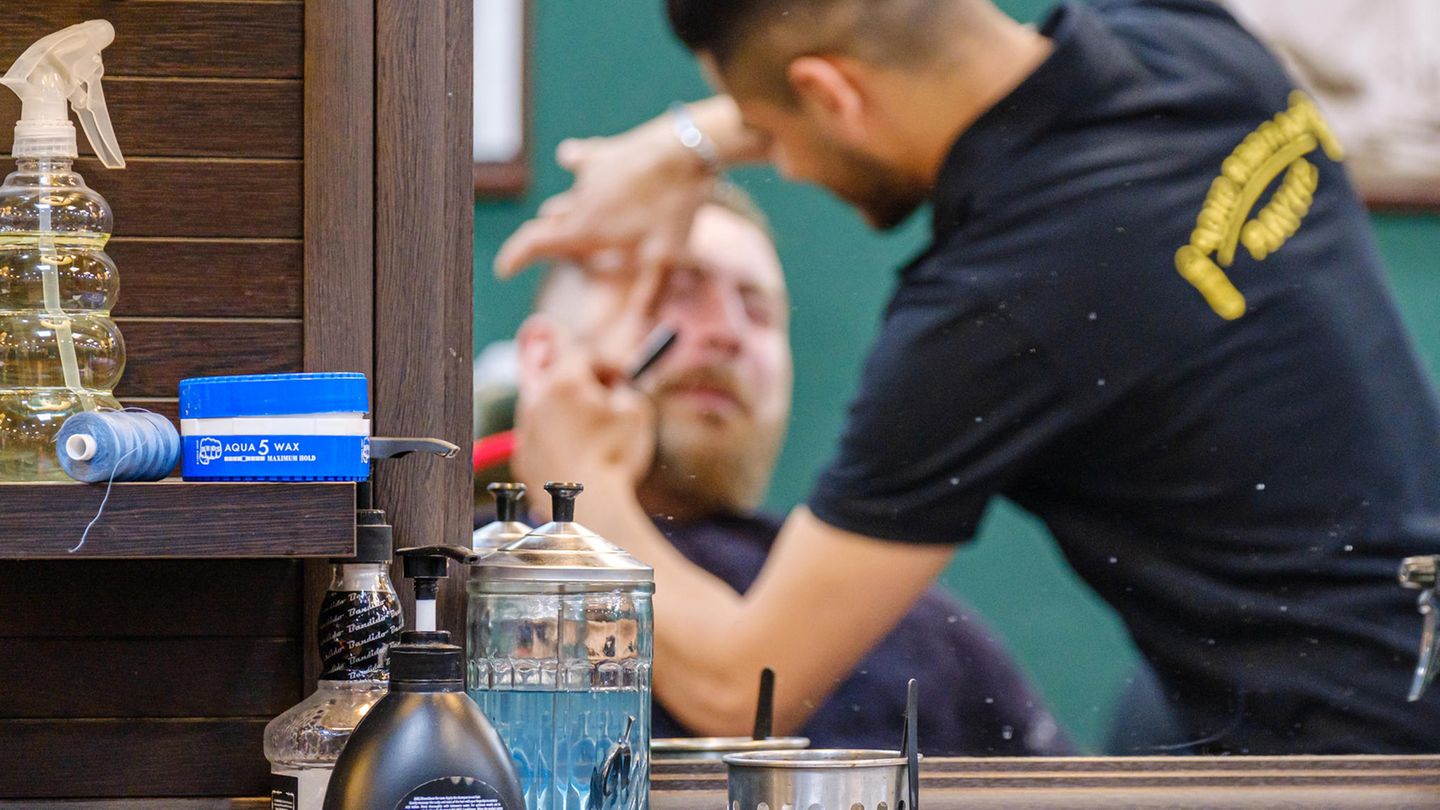Skin fungal infections are on the rise. Barbershops are said to be the main culprits. Is there any truth to this? Prof. Dr. Hans-Jürgen Tietz is an expert on fungal diseases. star he answered the most important questions.
The reports have been circulating for weeks. The skin fungus Trichophyton tonsurans is spreading and can lead to nasty abscesses and permanent hair loss. The main drivers of the wave of infections are said to be barbershops, where fungal spores are said to be passed from one customer to the next via contaminated razor blades. It is speculated that there is too little disinfection, the customer frequency is too high and the staff is too untrained.
The call for infection control by health authorities is getting louder. There is neither official documentation of the infection numbers nor 100% proof that the infections occurred in barbershops. Are the barbershops being made the scapegoat here or is the blame actually justified? Prof. Dr. Hans-Jürgen Tietz knows a lot about skin fungi. He heads the mycoclinic, an institute for fungal diseases, in Berlin. In connection with the reporting on Trichophyton tonsurans, he speaks of “terrifying scaremongering”. The star he answered the most important questions on the topic.
Is the skin fungus Trichophyton tonsurans a new problem?
No.
Trichophyton tonsurans is not new. The filamentous fungus has been spreading in Germany since the 1990s. It was originally brought in as a souvenir by people who brought it back from competition trips to the United States, which is why the fungus is also called wrestler’s fungus or mat fungus, explains Prof. Dr. Hans-Jürgen Tietz to the “Stern” newspaper. “Trichophyton tonsurans is still an unsolved problem in German wrestling. You could say that the entire Bundesliga is infected,” says the mycology expert.
© Tietz
To person
Prof. Dr. Hans-Jürgen Tietz is a microbiology specialist and a specialist in infectious diseases of the skin. He heads the mycoclinic, an institute for fungal diseases, in Berlin.
It is spread there through very intensive skin contact or contaminated soil. Recently, however, experts like Tietz have observed an increase in the number of people affected who are not martial artists. Barbershops are becoming the focus of attention. But wrestling is not the only source. The fungus also migrates from Africa on the heads of children. There are also indications that the fungus is widespread in the Turkish population. However, there are no exact figures for this either, says Tietz.
Is it easy to get infected?
No.
Trichophyton tonsurans is anthropophilic, which means that it is transmitted from person to person. “The fungus is contagious, but not highly contagious,” says Prof. Tietz. By comparison, it is unlikely that you will become infected with Trichophyton tonsurans through normal skin contact, according to Prof. Tietz. The situation is different with another skin fungus, for example, the cat fungus. “If you stroke a cat in Mallorca, even light skin contact is enough to cause an infection. The cat fungus is very contagious,” says the expert.
The microbiology specialist and specialist in infectious skin diseases assumes that a skin injury, as a kind of gateway, is essential for an infection. This includes even small scratches or cuts, such as those that can occur in a barbershop or hair salon. If the equipment used is not cleaned sufficiently, it is possible that fungal spores can be transmitted via the razor blades.
How many infected people are we currently talking about?
It is unknown.
Since 2001, fungal infections no longer have to be reported to the health authorities. “And if there is no obligation to report, there are no figures either – neither for athlete’s foot, vaginal fungi or Trichophyton tonsurans,” says mycologist Tietz. The figures can only be estimated. Tietz himself has been observing the increase in infections for three or four years. He is not alone. Almost every dermatologist he talks to reports cases.
“There are about 4,000 dermatologists in Germany. If each one has two to three cases, we get about 10,000 cases. And that is a low estimate,” he says. The University Hospital in Erlangen is now reporting cases of Trichophyton tonsurans to the responsible health authority. The senior physician at the dermatology clinic there, Dr. Petra Wörl, spoke to the ” of a tenfold increase in cases. Dermatologist Martin Schaller from the University Hospital in Tübingen told the ” that the skin fungus is being detected three to five times more often there than five years ago. He speaks of a “Europe-wide epidemic.”
Does an infection with the skin fungus Trichophyton tonsurans need to be treated?
Yes.
The pathogen penetrates the skin naturally or is introduced into the skin, for example by a razor or a comb. After about ten days, circular spots, so-called fairy rings, appear on the skin and itch. Although the symptoms are often confused with a bacterial cause, they are actually a sign of a skin fungus, explains Tietz. “If the symptoms are ignored, the next stage can lead to the fungus penetrating the hair root and attacking the hair follicles.”
As a result, the hair falls out in this area and a circular bald spot appears. If the fungus is not treated, these areas can remain permanently bald. It can also happen that the fungus spreads and eventually the entire head is bald or other parts of the body are affected. Prof. Tietz therefore advocates rapid diagnosis.

Because of her birthmarks she was called “Dalmatian” – today Yulianna is an Instagram star
01:13mins
Because, says the expert: “The good news is that the fungus can be treated very well with tablets, for example. Then the hair loss will not persist.” Thorough treatment immediately breaks the chain of infection so that the pathogen cannot be passed on – to the environment or other people. Treatment can take several weeks, but those affected are usually no longer contagious after about a week. The problem: many patients do not go to the doctor until weeks or even months after the infection.
Recently, there have also been cases of purulent abscesses on the head. Such inflammations were not previously a symptom of the fungus. The microbiology specialist therefore assumes that the skin fungus has transformed and that it could now be a new, more unpleasant variant of Trichophyton tonsurans.
Can the fungus also attack internal organs?
No.
The fungus primarily causes inflammation on the scalp, but can also affect the entire body. This is then called tinea capitis. Since the fungus, like all skin fungi, feeds on keratin, which does not occur inside the body, it can never affect the entire system.
Do fungal skin infections really occur more frequently in barbershops?
Most likely.
According to Prof. Tietz, several factors come together in barbershops that promote infection with the fungus: On the one hand, these are places of social gatherings that are usually very busy. The more customers, the higher the probability that there will be someone there who can be seen as a source of infection. On the other hand, working on a customer with skin fungus can contaminate the instruments. In addition, the fine shave can cause injuries, which in turn promote infection.
Determining where an infection has occurred is difficult. However, Prof. Tietz does not believe that it is a coincidence that many of those currently infected have the fungus on the back of their necks behind their ears. “This is still not 100% proof that the infection occurred in a barbershop, but it is likely,” says the expert. He suspects: “The fungus made the jump from the mat to the barbershop or hairdressers.” Researchers from Duisburg had already found in a study in 2020 that the fungus can be transmitted through contaminated hair cutting equipment.
Is poor hygiene a factor in the transmission of the skin disease?
Yes.
To avoid the fungal spores being passed on, the instruments must be disinfected between customers. This is the case in barbershops, but also in conventional hairdressing salons, for example. Expert Tietz doubts whether this always happens in practice. Although disinfection in hairdressing salons is at least theoretically part of the German master craftsman regulations and unlike in barbershops.
Is there a solution to the current skin fungus problem?
Yes and no.
The simple answer: The instruments used should be disinfected after each customer. It is questionable how feasible this is in everyday working life and how easy it is for the customer to check whether disinfection has taken place properly. However, health authorities could monitor the shops for health and hygiene. Customers who want to play it safe can resort to another measure. “The idea is a bit absurd, but realistic. The ‘morning after pill’ principle. Anyone who is anxious but does not want to miss out on the art of cutting hair in a barbershop can wash their hair at home with an anti-fungal shampoo as a preventative measure,” says Prof. Tietz.
Source: Stern
I’m Caroline, a journalist and author for 24 Hours Worlds. I specialize in health-related news and stories, bringing real-world impact to readers across the globe. With my experience in journalism and writing in both print and online formats, I strive to provide reliable information that resonates with audiences from all walks of life.




